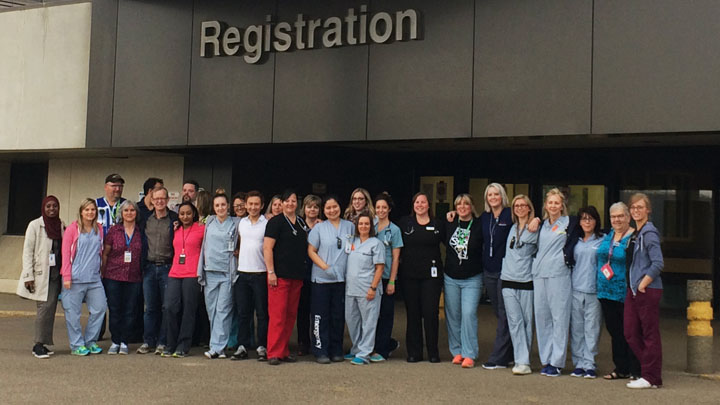
June 1, 2016

Every ceiling tile in the NLRHC had to be replaced – over 8,000 of them.
Story by Jason Morton; Photo by Christi Retson-Spalding
FORT MCMURRAY - On May 4, Gordon Dancey, an AHS Facility Maintenance and Engineering (FME) employee, lost his home and all his possessions through the devastating wildfires in Fort McMurray that destroyed his neighbourhood and threatened the entire city.
A couple of weeks later, while still evacuated and living at a friend’s place in a nearby community, he received a call from his boss asking him if he wanted to be part of a team to help get the Northern Lights Regional Health Centre (NLRHC) ready for the return of residents.
“I didn’t hesitate, I wanted to help out any way I could,” says Dancey. “It was important for me to lend a hand, but it was also a sort of therapy to help keep me busy, give me purpose and come to terms with everything I lost.”
Dancey is one of at least three AHS FME employees who - despite losing their homes - worked 12 to 15 hour days to get the site ready, so Fort McMurray residents could return to their homes and lives.
“It’s unbelievable to see the support from staff and vendors who’ve stepped up to do whatever it takes to get the hospital up and running,” says Jimmy Aumont, Maintenance Manager, NLRHC.
“I get emotional when I think about the people who lost so much and still volunteered to take on this challenge,” he says. “I think it really demonstrates the type of dedication all AHS staff and our vendors have shown during this challenging period.”
Before residents could return to Fort McMurray, facilities that provided essential services, including the Health Centre’s Emergency Department, needed to be up and running.
Since Sunday, May 21st, more than 500 vendors and AHS staff members have worked in shifts around the clock to prepare the NLRHC for the return of residents in the coming days.
That work allowed AHS to reopen the hospital’s Emergency Department on June 1, coinciding with the first phase of public re-entry into Fort McMurray.
The remainder of the hospital will open in phases, with most services operational by June 21.
The NLRHC did not suffer any fire damage, but there were significant issues caused by smoke and water.
Water sprayed on the hospital’s roof to protect it during the peak of the fire caused some damage in an office area on the third floor and in the Medical Device Reprocessing (MDR) unit. The water damage in the MDR was quickly repaired and will not affect any of the clinical areas.
“The biggest issue was the smoke caused by the fire and it was obvious when you walked into the hospital,” says David Ponich, AHS North Zone Director, FME. “Smoke made its way into the building leaving behind a strong smell and some residue, which compromised some of the hospital infrastructure and equipment.”
Every ceiling tile in the facility (nearly 8,200 of them) had to be removed and replaced because of the smoke smell and residue.
Special measures were taken to clean the ventilation system to remove the smoke smell, including the installation of a temporary charcoal filter. The water systems are continually being flushed out and both air and water quality is tested regularly to ensure they meet AHS’ high health and safety standards.
Carpets, linens, curtains, and towels have to be cleaned and others replaced to remove the smoke smell. Several walls are being re-painted. Hundreds of pieces of medical and lab equipment are being cleaned, tested, and verified to ensure they were not affected by the smoke.
A team of electricians and plumbers continue to go through the site room by room to ensure the plumbing and electrical systems are functioning properly.
“It was quite the undertaking,” says Aumont. “You can imagine the coordination of having so many vendors and staff working on various projects throughout the building at all hours. It’s been a real team effort with our staff and our vendors. ”
The remediation work is taking part in phases. The first phase focused on getting the common areas, the Emergency Department, Diagnostic Imaging and Labs ready for early occupation.
“The safety and health of our staff and patients remains our primary concern for all our cleanup work,” says Ponich.
“We only open a unit or department after it’s been extensively inspected and approved by Infection Prevention and Control in addition to Workplace Health and Safety.”
For Dancey, his focus remains on getting the remainder of hospital up and running. He hasn’t had too much time to think about what will happen to his living situation after that.
“For now, I just hope we can help out the residents of Fort McMurray,” he says. “I think getting the hospital operational will help boost the morale of the community which is important.
“It’s kind of symbolic of life returning to some sort of normalcy,” he adds. “I’ll worry about everything else later.”